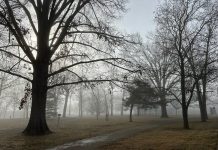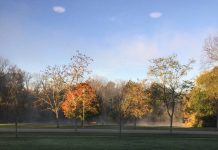By Sara Clifford | For The Republic
The fire on Town Hill early Christmas Eve morning not only destroyed a local man’s home, it also destroyed a landmark in Brown County art history.
C. Carey Cloud designed hundreds of Cracker Jack toys and produced countless sketches and paintings in the cabin overlooking downtown Nashville.
The Brown County Interim Report, a document of historic structures in Brown County, lists it as being built around 1880.
Cloud and his wife, Vera, bought it from artist Mary Vawter, the ex-wife of artist Will Vawter, around 1947, according to Cloud’s memoir, “On Cloud Nine.” The cabin became his studio, office and workshop, while the 1908 Vawter home, about 350 feet from it, became the Cloud home.
In a Christmas card Cloud sent that year, he estimated the hewn logs on the cabin to be “probably over a hundred years old” but wrote that “the interior has just been completely modernized and is up to date as North Michigan Avenue, Chicago.”
The fire started in a bedroom of the cabin, said Brown County (Nashville) Volunteer Fire Department Chief Nick Kelp. Much of it still is standing, but fire broke through the roof and the walls and charred the inside. Its cause was undetermined.
Charlie House had rented the cabin for 11 years and was in Kentucky spending Christmas with family when the fire started. He lost everything, including his pet cat, in the fire, said his father, Tony House. A GoFundMe page has been set up to help him.
The cabin is owned by a couple from Columbus, he said.
Brown County Historical Society member Pauline Hoover, who used to clean houses in that neighborhood, confirmed that this was the cabin Cloud used as his studio until the early 1980s. “Sorry anyone had a fire, but one of our historic places makes it sad,” she said.
Cloud, his wife, Vera, and children had first come to Brown County in the late 1920s on vacation from Chicago. He was working in the art department of the Baumgarth Calendar Company at the time and he craved the quieter existence of the hills.
When his company built new offices in South Bend, he chose not to go with them and bought the studio of artist Adolph Shulz on Locust Lane in Nashville instead. There, he painted infrequently and did freelance work for several publishers, and started a single-panel cartoon, “Luke Barker,” for a newspaper syndicate. But the Great Depression caused his work to dry up, and the family returned to the city, his book said.
Cracker Jack was what allowed Cloud to eventually return to Brown County. In 1937, he was doing artwork for the company’s advertising department when his manager suggested he talk to the prize buyer, as the company wanted to stop importing toys from Japan.
Cloud presented ideas for making toys out of tin, then cardboard and paper and eventually plastic. He handled the design as well as their production. When the war made metal scarce, he used scrap metal from Ball Brothers canning lids, which were produced in Muncie.
When the war was over, another company purchased the Chicago building where Cloud had been working, and he approached his employer about moving. “(I) discovered the officials didn’t care where I was located, as long as I kept sending in toys,” Cloud wrote.
He and his family relocated to Nashville and bought the Town Hill property.
For awhile, Cloud had maintained a studio and office in downtown Nashville because he could not get phone service on the hill. That didn’t come until 1953, he wrote.
“Restored, the log cabin became my office and studio,” Cloud wrote in his memoir, published in 1983. “I had electricity installed where only lamplight had been used in the past. Only a wagon trail had led to the place; I made it into a wide stone road. All this was another challenge I thoroughly enjoyed.”
The Town Hill home and studio were surrounded by 195 acres of forest and a private lake. That property and the view of the village down below provided a wealth of inspiration for Cloud’s art.
“The view was grand,” wrote Cloud’s second wife, Bobbie Hill-Cloud, whom he married three weeks before his death at age 85 in 1984. “The place had a lovely chalet-type home and a 100-year-old caretaker’s cabin, which Carey later used for his studio for over 30 years, and where millions of toys were designed. In 1964, in that unique cabin, was the beginning of his serious commitment to painting.”
One of his favorite subjects was old buildings, especially barns and farms that reminded him of his childhood in Grant County, northeast of Indianapolis.
“I have a benevolent feeling for my humble subjects: old ramshackle houses, sagging window frames, splintered clapboards,” he wrote. “… I have found strength and energy in this subjects and joy in making others aware of the passing scene, bringing back quiet memories of a more vibrant past.”
Last year, the Brown County Historical Society was able to secure, through a major donation from Tim and Sarah Burke and some board members, a primitive oil painting by Cloud, called “Raccoon Ridge Romance,” said society member Rita Simon.
In a 1953 column in the Indianapolis Star, Frank Hohenberger singled out that painting in writing about a show at the Brown County Art Gallery: “It was catalogued ‘Raccoon Ridge Romance,’ but it didn’t fool anyone, and it was accepted by viewers for no other than than ‘Shotgun Wedding,” he wrote. “When pressed for the location of his subjects, Cloud shied away with this remark, ‘Now, after all, I intend to live a long time and paint more in these hills. I don’t want that shotgun pointing my way.’”
Cloud began selling home sites on his hill in 1956, according to an advertisement in the Brown County Democrat. That subdivision was called Cloudcrest Hills. The county’s GIS map shows the original Cloudcrest Hills spanning all of Town Hill West, much of the main road starting at the top of the hill, and the western portion of Town Hill East to Southridge Trail. That land now holds about 20 homes.
A sign on Town Hill Road at its intersection with State Road 46 West points a half-mile up the hill to Cloudcrest Hills. “This sign erected (circa 1952) by C. Carey Cloud, artist, inventor and manufacturer of Cracker Jack toys,” it says.
The sign was destroyed in 1992, according to a photo in the Brown County Democrat. A Cloudcrest resident salvaged the good parts of the sign and put them into a new frame, and added the two-line history about Cloud in 1993.
Cloud never finished grade school, and his only training in art was a $25 correspondence course. He worked as a farmhand, on the railroad, in a steel mill, and in shoe, glass and piano factories before achieving his lifelong dream of becoming an artist, and he never stopped working.
“I probably could have obtained greater financial reward had I chosen to live in New York,” Cloud wrote in his memoir at age 82. “But I attained a greater spiritual reward by choosing to live among my trees on my hills.”




